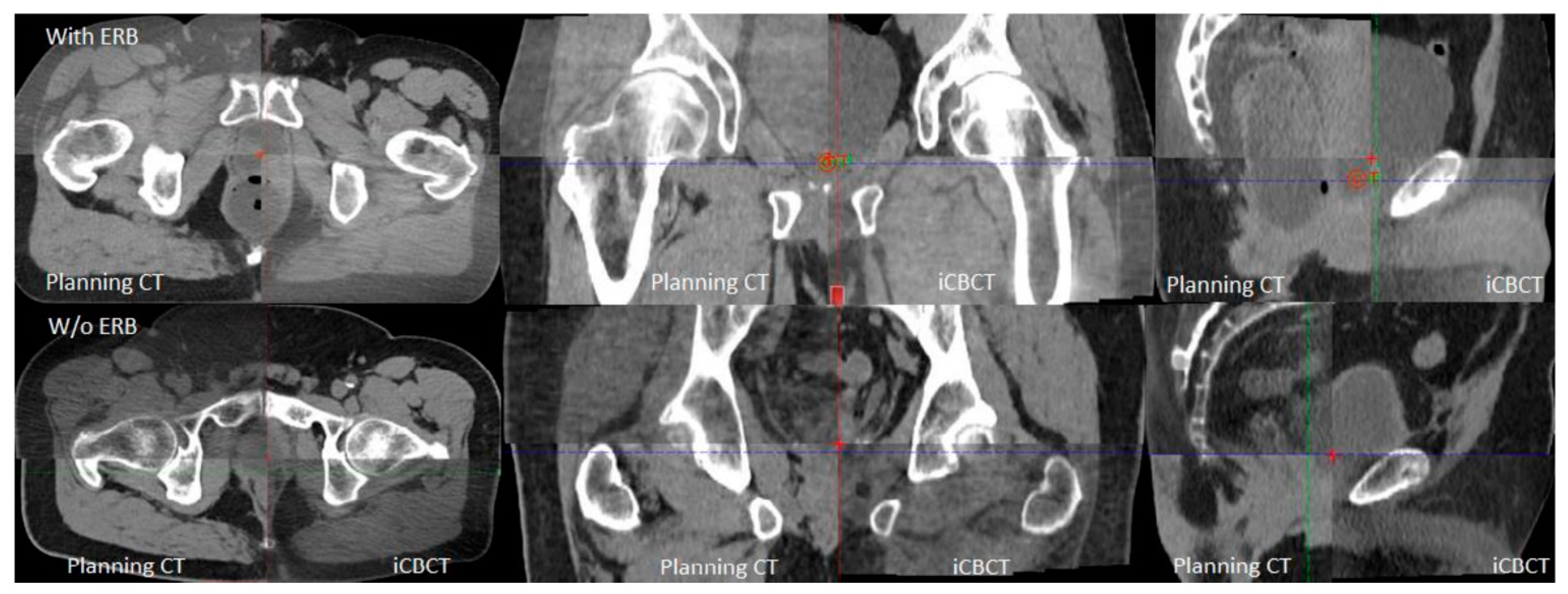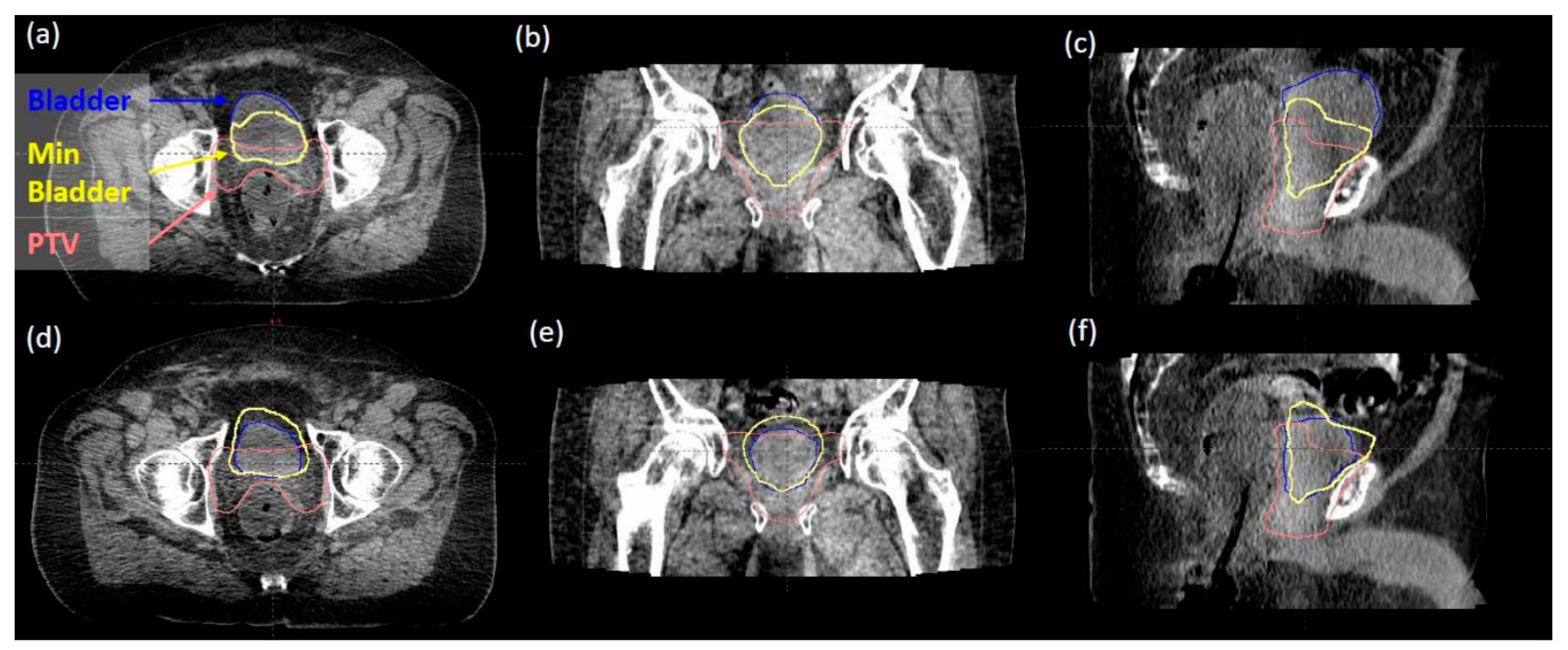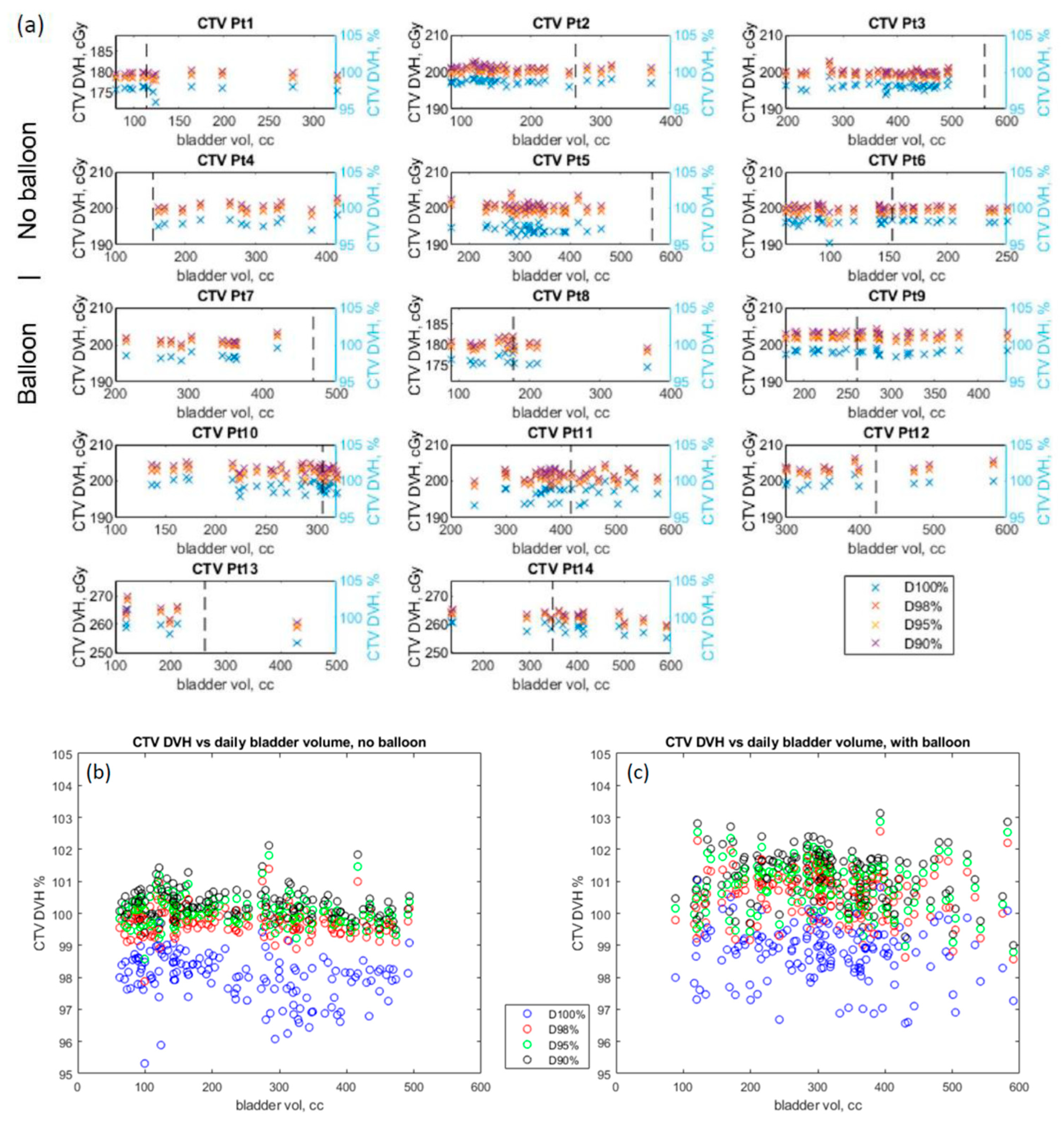Clinical Practice Evolvement for Post-Operative Prostate Cancer Radiotherapy—Part 1: Consistent Organs at Risk Management with Advanced Image Guidance
Abstract
Simple Summary
Abstract
1. Introduction
2. Materials and Methods
Statistical Analysis
3. Results
4. Discussion
5. Conclusions
Author Contributions
Funding
Institutional Review Board Statement
Informed Consent Statement
Data Availability Statement
Conflicts of Interest
Abbreviations
| CBCT | cone-beam computed tomography |
| CTV | Clinical target volume |
| DVH | dose volume histogram |
| ERB | Endorectal balloon |
| FDK | Feldkamp–Davis–Kress |
| FROGG | Faculty of Radiation Oncology Genito-Urinary Group |
| GU | genitourinary |
| iCBCT | iterative cone-beam computed tomography |
| IGRT | Image-guided radiotherapy |
| MRI | Magnetic resonance imaging |
| OAR | organ-at-risk |
| PTV | planning target volume |
| RT | Radiotherapy |
| VMAT | Volumetric modulated radiation therapy |
References
- Pisansky, T.M.; Thompson, I.M.; Valicenti, R.K.; D’Amico, A.V.; Selvarajah, S. Adjuvant and Salvage Radiotherapy after Prostatectomy: ASTRO/AUA Guideline Amendment 2018-2019. J. Urol. 2019, 202, 533–538. [Google Scholar] [CrossRef] [PubMed]
- Fiorino, C.; Foppiano, F.; Franzone, P.; Broggi, S.; Castellone, P.; Marcenaro, M.; Calandrino, R.; Sanguineti, G. Rectal and bladder motion during conformal radiotherapy after radical prostatectomy. Radiother. Oncol. 2005, 74, 187–195. [Google Scholar] [CrossRef] [PubMed]
- Bell, L.J.; Cox, J.; Eade, T.; Rinks, M.; Kneebone, A. The impact of rectal and bladder variability on target coverage during post-prostatectomy intensity modulated radiotherapy. Radiother. Oncol. 2014, 110, 245–250. [Google Scholar] [CrossRef] [PubMed]
- Kishan, A.; Tyran, M.; Steinberg, M.L.; Holden, S.B.; Cao, M. MRI-guided Dose-escalated Salvage Radiotherapy for Bulky Bladder Neck Recurrence of Prostate Cancer. Cureus 2018, 10, e2360. [Google Scholar] [CrossRef] [PubMed]
- Nasser, N.J.; Fenig, E.; Klein, J.; Agbarya, A. Maintaining consistent bladder filling during external beam radiotherapy for prostate cancer. Technol. Innov. Patient Support Radiat. Oncol. 2021, 17, 1–4. [Google Scholar] [CrossRef]
- Buyyounouski, M.K.; Pugh, S.; Chen, R.C.; Mann, M.; Kudchadker, R.; Konski, A.A.; Mian, O.Y.; Michalski, J.M.; Vigneault, E.; Valicenti, R.K.; et al. Primary endpoint analysis of a randomized phase III trial of hypofractionated vs. conventional post-prostatectomy radio-therapy: NRG Oncology GU003. Int. J. Radiat. Oncol. Biol. Phys. 2021, 111, S2–S3. [Google Scholar] [CrossRef]
- Ma, T.M.; Ballas, L.K.; Wilhalme, H.; Sachdeva, A.; Chong, N.; Sharma, S.; Yang, T.; Basehart, V.; Reiter, R.E.; Saigal, C.; et al. Quality-of-Life Outcomes and Toxicity Profile Among Patients With Localized Prostate Cancer After Radical Prostatectomy Treated With Stereotactic Body Radiation: The SCIMITAR Multicenter Phase 2 Trial. Int. J. Radiat. Oncol. Biol. Phys. 2022, 115, 142–152. [Google Scholar] [CrossRef]
- Laughlin, B.S.; Voss, M.M.; Toesca, D.A.; Daniels, T.; Golafshar, M.A.; Keole, S.R.; Wong, W.W.; Rwigema, J.C.; Davis, B.; Schild, S.E.; et al. Preliminary Analysis of a Phase II Trial of Stereotactic Body Radiotherapy for Prostate Cancer with High-Risk Features after Radical Prostatectomy. Adv. Radiat. Oncol. 2022, 10, 101143. [Google Scholar] [CrossRef]
- Vargas, C.; Saito, A.; Hsi, W.C.; Indelicato, D.; Falchook, A.; Zengm, Q.; Oliver, K.; Keole, S.; Dempsey, J. Cine-Magnetic Resonance Imaging Assessment of Intrafraction Motion for Prostate Cancer Patients Supine or Prone with and Without a Rectal Balloon. Am. J. Clin. Oncol. 2010, 33, 11–16. [Google Scholar] [CrossRef]
- Kim, Y.S.; Joo, J.H.; Kim, Y.J.; Cho, Y.P.; Lee, H.Y.; Jeong, C.Y.; Kwak, J.; Cho, B.C. Analysis of prostate bed motion using an endorectal balloon and cone beam computed tomography during postprostatectomy radiotherapy. OncoTargets Ther. 2016, 9, 3095–3100. [Google Scholar] [CrossRef]
- Wachter, S.; Gerstner, N.; Dorner, D.; Goldner, G.; Colotto, A.; Wambersie, A.; Pötter, R. The influence of a rectal balloon tube as internal immobilization device on variations of volumes and dose-volume histograms during treatment course of conformal radiotherapy for prostate cancer. Int. J. Radiat. Oncol. 2002, 52, 91–100. [Google Scholar] [CrossRef] [PubMed]
- Smeenk, R.J.; van Lin, E.N.; van Kollenburg, P.; McColl, G.M.; Kunze-Busch, M.; Kaanders, J.H. Endorectal balloon reduces anorectal doses in post-prostatectomy intensity-modulated radiotherapy. Radiother. Oncol. 2011, 101, 465–470. [Google Scholar] [CrossRef] [PubMed]
- Jameson, M.G.; De Leon, J.; Windsor, A.A.; Cloak, K.; Keats, S.; A Dowling, J.; Chandra, S.S.; Vial, P.; Sidhom, M.; Holloway, L.; et al. Endorectal balloons in the post prostatectomy setting: Do gains in stability lead to more predictable dosimetry? Radiother. Oncol. 2013, 109, 493–497. [Google Scholar] [CrossRef] [PubMed]
- Potters, L.; Gaspar, L.E.; Kavanagh, B.; Galvin, J.M.; Hartford, A.C.; Hevezi, J.M.; Kupelian, P.A.; Mohiden, N.; Samuels, M.A.; Timmerman, R.; et al. American Society for Therapeutic Radiology and Oncology (ASTRO) and American College of Radiology (ACR) Practice Guidelines for Image-Guided Radiation Therapy (IGRT). Int. J. Radiat. Oncol. 2010, 76, 319–325. [Google Scholar] [CrossRef] [PubMed]
- Vilotte, F.; Antoine, M.; Bobin, M.; Latorzeff, I.; Supiot, S.; Richaud, P.; Thomas, L.; Leduc, N.; Guérif, S.; Iriondo-Alberdi, J.; et al. Post-Prostatectomy Image-Guided Radiotherapy: The Invisible Target Concept. Front. Oncol. 2017, 7, 34. [Google Scholar] [CrossRef][Green Version]
- Haworth, A.; Paneghel, A.; Herschtal, A.; Duchesne, G.; Williams, S.; Tai, K.; Kron, T.; Roxby, P.; Soteriou, S.; Laferlita, M.; et al. Verification of target position in the post-prostatectomy cancer patient using cone beam CT. J. Med. Imaging Radiat. Oncol. 2009, 53, 212–220. [Google Scholar] [CrossRef]
- Siewerdsen, J.H.; Jaffray, D.A. Cone-beam computed tomography with a flat-panel imager: Magnitude and effects of x-ray scatter. Med. Phys. 2001, 28, 220–231. [Google Scholar] [CrossRef]
- Endo, M.; Tsunoo, T.; Nakamori, N.; Yoshida, K. Effect of scattered radiation on image noise in cone beam CT. Med. Phys. 2001, 28, 469–474. [Google Scholar] [CrossRef]
- Lim, R.; Penoncello, G.P.; Hobbis, D.; Harrington, D.P.; Rong, Y. Technical note: Characterization of novel iterative reconstructed cone beam CT images for dose tracking and adaptive radiotherapy on L-shape linacs. Med. Phys. 2022. Epub ahead of print. [Google Scholar] [CrossRef]
- Sidhom, M.A.; Kneebone, A.B.; Lehman, M.; Wiltshire, K.L.; Millar, J.; Mukherjee, R.K.; Shakespeare, T.P.; Tai, K.-H. Post-prostatectomy radiation therapy: Consensus guidelines of the Australian and New Zealand Radiation Oncology Genito-Urinary Group. Radiother. Oncol. 2008, 88, 10–19. [Google Scholar] [CrossRef]
- Wang, A.; Maslowski, A.; Messmer, P.; Lehmann, M.; Strzelecki, A.; Yu, E.; Paysan, P.; Brehm, M.; Munro, P.; Star-Lack, J.; et al. Acuros CTS: A fast, linear Boltzmann transport equation solver for computed tomography scatter—Part II: System modeling, scatter correction, and optimization. Med. Phys. 2018, 45, 1914–1925. [Google Scholar] [CrossRef] [PubMed]
- Maslowski, A.; Wang, A.; Sun, M.; Wareing, T.; Davis, I.; Star-Lack, J. Acuros CTS: A fast, linear Boltzmann transport equation solver for computed tomography scatter—Part I: Core algorithms and validation. Med. Phys. 2018, 45, 1899–1913. [Google Scholar] [CrossRef] [PubMed]
- Ingrosso, G.; Miceli, R.; Ponti, E.; Lancia, A.; di Cristino, D.; de Pasquale, F.; Bove, P.; Santoni, R. Interfraction prostate displacement during image-guided radiotherapy using intraprostatic fiducial markers and a cone-beam computed tomography system: A volumetric off-line analysis in relation to the variations of rectal and bladder volumes. J. Cancer Res. Ther. 2019, 15, 69–75. [Google Scholar] [CrossRef] [PubMed]
- Kim, S.; You, S.H.; Eum, Y.J. Assessment of inter- and intra-fractional volume of bladder and body contour by mega-voltage computed tomography in helical tomotherapy for pelvic malignancy. Radiat. Oncol. J. 2018, 36, 235–240. [Google Scholar] [CrossRef]
- Kishan, A.U.; Tyran, M.; Weng, J.; Upadhyaya, S.; Lamb, J.; Steinberg, M.; King, C.; Cao, M. Stereotactic body radiotherapy to the prostate and pelvic lymph nodes: A detailed dosimetric analysis of a phase II prospective trial. Br. J. Radiol. 2019, 92, 20181001. [Google Scholar] [CrossRef]
- Nejad-Davarani, S.P.; Sevak, P.; Moncion, M.; Garbarino, K.; Weiss, S.; Kim, J.; Schultz, L.; Elshaikh, M.A.; Renisch, S.; Glide-Hurst, C. Geometric and dosimetric impact of anatomical changes for MR-only radiation therapy for the prostate. J. Appl. Clin. Med. Phys. 2019, 20, 10–17. [Google Scholar] [CrossRef]
- Happersett, L.; Damato, A.; Elguindi, S.; Gorovets, D. Minimum Bladder Reference Contour to Guide Patient Setup For Prostate Radiotherapy. Int. J. Radiat. Oncol. 2020, 108, e899. [Google Scholar] [CrossRef]
- Gorovets, D.; Happersett, L.; Elguindi, S.; Della-Biancia, C.; Kollmeier, M.; McBride, S.; Zelefsky, M.; Damato, A. Minimum Bladder Reference Contour to Guide Bladder Filling for Prostate Radiotherapy. Int. J. Radiat. Oncol. 2021, 111, e274–e275. [Google Scholar] [CrossRef]
- Roach, M.; Pickett, B.; Rosenthal, S.A.; Verhey, L.; Phillips, T.L. Defining treatment margins for six field conformal irradiation of localized prostate cancer. Int. J. Radiat. Oncol. 1994, 28, 267–275. [Google Scholar] [CrossRef]
- Haken, R.T.; Forman, J.; Heimburger, D.; Gerhardsson, A.; McShan, D.; Perez-Tamayo, C.; Schoeppel, S.; Lichter, A. Treatment planning issues related to prostate movement in response to differential filling of the rectum and bladder. Int. J. Radiat. Oncol. 1991, 20, 1317–1324. [Google Scholar] [CrossRef]
- de Crevoisier, R.; Tucker, S.L.; Dong, L.; Mohan, R.; Cheung, R.; Cox, J.D.; Kuban, D.A. Increased risk of biochemical and local failure in patients with distended rectum on the planning CT for prostate cancer radiotherapy. Int. J. Radiat. Oncol. 2005, 62, 965–973. [Google Scholar] [CrossRef] [PubMed]
- Cai, B.; Laugeman, E.; Mazur, T.R.; Park, J.C.; Henke, L.E.; Kim, H.; Hugo, G.D.; Mutic, S.; Li, H. Characterization of a prototype rapid kilovoltage x-ray image guidance system designed for a ring shape radiation therapy unit. Med. Phys. 2019, 46, 1355–1370. [Google Scholar] [CrossRef] [PubMed]
- Jarema, T.; Aland, T. Using the iterative kV CBCT reconstruction on the Varian Halcyon linear accelerator for radiation therapy planning for pelvis patients. Phys. Medica 2019, 68, 112–116. [Google Scholar] [CrossRef] [PubMed]
- Yoon, S.; Cao, M.; Aghdam, N.; Shabsovich, D.; Kahlon, S.; Ballas, L.; Collins, S.; Steinberg, M.L.; Kishan, A.U. Prostate bed and organ-at-risk deformation: Prospective volumetric and dosimetric data from a phase II trial of stereotactic body radiotherapy after radical prostatectomy. Radiother. Oncol. 2020, 148, 44–50. [Google Scholar] [CrossRef] [PubMed]
- Cao, M.; Gao, Y.; Yoon, S.M.; Yang, Y.; Sheng, K.; Ballas, L.K.; Basehart, V.; Sachdeva, A.; Felix, C.; Low, D.A.; et al. Interfractional Geometric Variations and Dosimetric Benefits of Stereotactic MRI Guided Online Adaptive Radiotherapy (SMART) of Prostate Bed after Radical Prostatectomy: Post-Hoc Analysis of a Phase II Trial. Cancers 2021, 13, 2802. [Google Scholar] [CrossRef] [PubMed]
- Kishan, A.U.; Lamb, J.; Casado, M.; Wang, X.; Ma, T.M.; Low, D.; Sheng, K.; Yang, Y.; Gao, Y.; Basehart, V.; et al. Magnetic resonance imaging-guided versus computed tomography-guided stereotactic body radiotherapy for prostate cancer (MIRAGE): Interim analysis of a phase III randomized trial. J. Clin. Oncol. 2022, 40, 255. [Google Scholar] [CrossRef]
- Padhani, A.R.; Khoo, V.S.; Suckling, J.; E Husband, J.; O Leach, M.; Dearnaley, D.P. Evaluating the effect of rectal distension and rectal movement on prostate gland position using cine MRI. Int. J. Radiat. Oncol. 1999, 44, 525–533. [Google Scholar] [CrossRef]
- Ghilezan, M.J.; Jaffray, D.; Siewerdsen, J.H.; van Herk, M.; Shetty, A.; Sharpe, M.B.; Jafri, S.Z.; Vicini, F.A.; Matter, R.C.; Brabbins, D.S.; et al. Prostate gland motion assessed with cine-magnetic resonance imaging (cine-MRI). Int. J. Radiat. Oncol. 2005, 62, 406–417. [Google Scholar] [CrossRef]
- De Leon, J.F.; Jameson, M.G.; Windsor, A.; Cloak, K.; Keats, S.; Vial, P.; Holloway, L.; Metcalfe, P.; Sidhom, M. Superior target volume and organ stability with the use of endorectal balloons in post-prostatectomy radiotherapy. J. Med. Imaging Radiat. Oncol. 2015, 59, 507–513. [Google Scholar] [CrossRef]






| Dose Constraint | Median Change | p-Value |
|---|---|---|
| Daily Change in Bladder Volume | ||
| CTV D90% | 0.0037 CGy | p = 0.006 |
| CTV D95% | −0.0017 cGy | p = 0.027 |
| Bladder V65% | −0.00084% | p < 0.001 |
| Rectal Balloon | ||
| CTV D90% | 1.61 cGy | p < 0.001 |
| CTV D95% | 1.54 cGy | p < 0.001 |
| Rectum V45% | 10.3 cGy | p < 0.001 |
Disclaimer/Publisher’s Note: The statements, opinions and data contained in all publications are solely those of the individual author(s) and contributor(s) and not of MDPI and/or the editor(s). MDPI and/or the editor(s) disclaim responsibility for any injury to people or property resulting from any ideas, methods, instructions or products referred to in the content. |
© 2022 by the authors. Licensee MDPI, Basel, Switzerland. This article is an open access article distributed under the terms and conditions of the Creative Commons Attribution (CC BY) license (https://creativecommons.org/licenses/by/4.0/).
Share and Cite
Laughlin, B.S.; Lo, S.; Vargas, C.E.; DeWees, T.A.; Van der Walt, C.; Tinnon, K.; Beckett, M.; Hobbis, D.; Schild, S.E.; Wong, W.W.; et al. Clinical Practice Evolvement for Post-Operative Prostate Cancer Radiotherapy—Part 1: Consistent Organs at Risk Management with Advanced Image Guidance. Cancers 2023, 15, 16. https://doi.org/10.3390/cancers15010016
Laughlin BS, Lo S, Vargas CE, DeWees TA, Van der Walt C, Tinnon K, Beckett M, Hobbis D, Schild SE, Wong WW, et al. Clinical Practice Evolvement for Post-Operative Prostate Cancer Radiotherapy—Part 1: Consistent Organs at Risk Management with Advanced Image Guidance. Cancers. 2023; 15(1):16. https://doi.org/10.3390/cancers15010016
Chicago/Turabian StyleLaughlin, Brady S., Stephanie Lo, Carlos E. Vargas, Todd A. DeWees, Charles Van der Walt, Katie Tinnon, Mason Beckett, Dean Hobbis, Steven E. Schild, William W. Wong, and et al. 2023. "Clinical Practice Evolvement for Post-Operative Prostate Cancer Radiotherapy—Part 1: Consistent Organs at Risk Management with Advanced Image Guidance" Cancers 15, no. 1: 16. https://doi.org/10.3390/cancers15010016
APA StyleLaughlin, B. S., Lo, S., Vargas, C. E., DeWees, T. A., Van der Walt, C., Tinnon, K., Beckett, M., Hobbis, D., Schild, S. E., Wong, W. W., Keole, S. R., Rwigema, J.-C. M., Yu, N. Y., Clouser, E., & Rong, Y. (2023). Clinical Practice Evolvement for Post-Operative Prostate Cancer Radiotherapy—Part 1: Consistent Organs at Risk Management with Advanced Image Guidance. Cancers, 15(1), 16. https://doi.org/10.3390/cancers15010016







